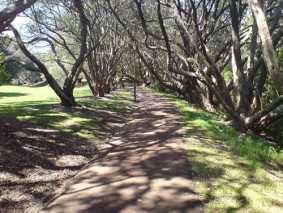The discovery of a long-missing body offers a rare chance to put the psychic stars of Sensing Murder to the test.
On Saturday 19 May 2012 the remains of Auckland teenager Jane Furlong were found in sand dunes at Port Waikato’s Sunset Beach.
Jane was only 17 went she went missing while working as a prostitute on Karangahape Rd in central Auckland, on the night of 26 May 1993. While the discovery gives her friends and family a chance to say farewell, mystery still surrounds her disappearance, and her killer remains at large.
The Jane Furlong case was the subject of the sixth episode of the second season of the television programme Sensing Murder, which screened in New Zealand on 9 October 2007. On the programme, two ‘psychics’, Australian Deb Webber and New Zealander Kelvin Cruickshank, attempted to contact Jane’s spirit and uncover fresh evidence about the case. They made specific and falsifiable claims about where the body was hidden; the discovery of Jane’s remains provides a rare opportunity to assess the information this pair came up with.
The programme’s narrator, New Zealand-born Australian actress Rebecca Gibney, tells us Webber and Cruickshank were both filmed non-stop for a day, kept separate and under constant supervision. The only information they were provided with was a photo of Jane, which both claimed they didn’t look at until they had come up with (very accurate) physical descriptions, including age (though both picked her as 16), ethnicity, even hairstyle. Both picked that she worked as a prostitute and dressed accordingly, was academically bright but had trouble at school. Webber even got the name ‘Jayne’, after having the name handed to her on a piece of paper, face down – we are told that Jane changed the spelling in her teens. (One has to ask whether the name was written in Webber’s presence: stage mentalists are able to interpret writing or drawing by watching the movements of the top of the pen, a technique known as pencil reading.(
Cruickshank gets that she had two siblings, that there was a Judy in the family (her mother’s name was Judith), and that she had a 19-year-old boyfriend, correctly described by Webber as rough-looking with tattoos. Later, both lead the camera crew (independently on separate nights) to the precise point on Karangahape Rd where Jane plied her trade.
On the face of it, this is amazing. If we have been given a fair representation of events there would seem little doubt that these two have genuine psychic ability. But there are other possibilities. One is that Webber and Cruickshank have been provided with all the information from the start. Another is that Webber and Cruickshank are filmed for a combined total of perhaps 16 hours, of which less than 30 minutes ends up on the screen, so there is plenty of opportunity for selective editing. Both are skilled cold readers (I have attended one of Cruickshank’s mediumship shows and can attest to his ability) , and we are told by Gibney that “only correct statements are confirmed during the readings”. So they are given feedback on how they’re doing, and over the course of the day’s filming are able to home in on correct details.
But could they really be psychic? On the evidence from this early part of the show it’s a possibility but we can’t be sure, because all of this information could have been obtained by non-psychic means.
However Cruickshank and Webber go on to give details about where Jane’s body was hidden. In 2007 nobody knew where that was, but now we do. So let’s look at a transcription of the bits of the show relating to that and see how well they did. ‘KC’ is Kelvin Cruickshank, ‘RG’ is Rebecca Gibney, and ‘DW’ is Deb Webber. Quotes are complete; three dots denote a pause, not an ellipsis.
KC: Just wanted to say dump or dumped. How are you covered? She’s saying to me I’m so covered up it’s not funny. She says they did a jolly good job of covering me up. Lots of dirt, lots of puddles, lots of water, I can hear dripping, I can hear hammers, even jack hammers, the concrete … jrr jrr jrr jrr. You know the… the sound of building.
[DW gives unverified details about the murderer.]
KC: Church, cemetery, where you taking me girlfriend? I feel like she’s hidden. She said, I just asked her were you moved from where you were killed? She shook her head … So … So the possibility at the time of her passing there may have been a building in dis…mount, which means being broken down and replaced ’cause things have changed since that sort of scenario … the surroundings have all changed and so I can’t make out whether I’m in or out.
[DW and KC say Jane is still missing.]
RG: Both psychics have picked up that Jane’s body is missing. Deb is given a map of Auckland and asked to identify areas that are significant to the case.
DW: She’s saying to me you don’t get much work out of the city. Where are you working? Yeah work? That’s what I’m looking for.
RG: Deb is indicating the area where Jane worked.
DW: Do you go over a bridge or something to get to her? ‘Cause she keeps taking me something over a bridge. Something’s happening around in this area, I don’t know what it is though.
RG: Deb is pointing at the Auckland Domain, a large park area near the central city.
DW: Still again, it’s like part of her doesn’t want to be found.
KW: She’s not outside of the city, she’s inside the city, she’s making reference to a park… She’s giving me the images of the hospital and then the museum and then she brings me back over to the university. Little bit of a triangle.
RG: Kelvin is also given a map.
KC: There’s the university, Domain, the hospital, where’s that? Right here … so … if we put two and two together like, there’s the triangle of the university like that, it sort of looks like this [makes a triangle with hands over the map].
RG: Significantly at the center of Kelvin’s triangle lies the Auckland Domain. The same park area identified by Deb.
KW: Honestly, I’m going to say this to you again, ’cause she’s talking about it being right underneath the noses of where she was last seen, it’s not far from there. She keeps saying I was not removed from the city. So wherever that area is, we’d probably need to locate it. Have a scout around with it, try and work with her a little bit more.
[DW and KC on separate evenings go to Jane’s “patch” on Karangahape Rd.]
DW: I think this is where she was last seen. And she keeps showing me the image of the car, coming in. It’s taken off, it’s turning around, and headed back down out that way.
RG: Deb is pointing in the direction of the Auckland Domain.


[DW says Jane knew something was not right, KC continues to explore Karangahape Rd.]
RG: Meanwhile Deb asks Jane’s spirit to show her where she was killed. She directs the crew to drive over the Grafton Bridge.
DW: She was on this road. I keep asking her when did he get violent with you and she said he was creepy anyway, right from the beginning. But it’s when they got down the road a bit, that’s when he started.
RG: Kelvin has reached the old Symonds St cemetery.
KC: Why have you brought me here girl? Definitely been pulled here, I don’t know why. I’ve brought these with me just in case, try and link in with her [Holds up bracelets(?)].
DW: Left.
RG: Deb heads into the Auckland Domain, the area both she and Kelvin identified on the map as being significant to the case.
DW: Oh, this is a bit … She’s definitely been in here before. She’s been in here. No, I think a few times but she’s definitely been in here with him. It’s really weird, I don’t think she came out the other side of it.
RG: Just when it seems Deb is about to make a breakthrough, Jane closes down on her.
DW: Getting all that stuff I got at the beginning, about the anger and the bitterness. You know, no one really cares if she gets found or not, she feels. She’s not connecting with her body, she doesn’t care. Show me, go show me Jayne. It’s like, the only thing I keep getting is that she’s lost, so until her soul’s ready to acknowledge it, it’s lost. Shock does that to a soul. Well, I can certainly say this, it’s not a very pleasant place to be at night, in here. Too much goes on in here.
RG: At the cemetery Jane is shutting down on Kelvin too.
KC: I’m getting close to a lot of people man, but this one I’m struggling with. She’s very very hard to get that door open. She comes in, she gives me a little bit, and she disappears, she comes in and gives me a little bit more and disappears, and that’s been paramount as you’ve been watching it all night. Didn’t have much in life and everything I did have was taken from me. What does it matter where I am. What does anyone care?
Next, we are introduced to Duncan Holland of Corporate Risks, an investigation and security consultancy, who is described as a former detective leading a team of investigators. He is solid-looking, authoritative, and speaks of the police and “we” in close conjunction. Many viewers would probably get the impression he is a policeman. Below are excerpts of his concluding commentary. Ellipses in this transcript indicate segments not relevant to the body’s location, or where clips of DW and KC had been inserted for dramatic or illustrative purposes.
Both psychics identified the Auckland Domain as being significant. … To get to the Auckland Domain from K Road where Jane worked the car would have driven past the Symonds St cemetery and the Grafton Bridge. … Psychic Deb Webber led the crew to the Auckland Domain, the same area she and Kelvin identified on the map. … The Auckland Domain, which is less than five minutes drive from K Road has always been a popular spot for sex workers to take clients; it is also one of the most dangerous spots. Numerous rapes and attacks on prostitutes have taken place in the domain. The New Zealand Prostitutes collective warns sex workers not to travel too far out of the city with clients. …
It is quite likely Jane went with her killer to the Auckland Domain, she may have been murdered and possibly even buried there. …
If the psychics are correct and Jane’s body was well covered, it is quite feasible that her body could be hidden in the domain and remain undetected for 14 years. The Auckland Domain covers 75 ha of land, some of it rough and inaccessible terrain and bush. In 1995 the body of murdered vagrant Betty Marusich was found in dense bush in the Auckland Domain; no attempt was made to cover or bury her yet it still took two weeks for her body to be found.
Kelvin presented another interesting scenario. … During our investigations we were approached by an anonymous source who told us that Jane’s body had been buried in concrete. Police confirmed they had investigated this theory but were unable to find any evidence. New Zealand police deal in factual evidence but are open to all sources of information. The psychics have revealed potential lines of inquiry which we believe warrant further investigation in the hunt for Jane Furlong’s body and her killer.
So there you have it. Both Webber and Cruickshank identify the same general area as the location of Jane’s remains, but then Jane inconveniently (or perhaps not) shuts down on them. Note that Cruickshank actually gives two alternatives: the Symonds St cemetery and a construction site, location unspecified. Interestingly Holland says there had been a tip-off that Jane had been buried in concrete.
Cruickshank and Webber also had plenty to say about the killer, though as the crime remains unsolved it’s impossible to assess this material. Much of it was contradictory, though the show glosses over this – Cruickshank indicated a motorcycle gang and “payback” being involved (Jane was due to testify in an assault case involving a gang), while Webber gave details about a balding businessman with an accent.
Was there collusion between Webber and Cruickshank for them both to pick locations that were so close together? Not necessarily. Both had somehow deduced she was a Karangahape Rd prostitute (most likely by cold reading their interviewers; we can now be fairly sure neither has any psychic ability), and the likeliest place for the body to be hidden would be the closest piece of rough ground – the Grafton Gully/Auckland Domain area.
In any case, Jane’s remains were more than 80 km away, at Port Waikato. The pattern is clear: Webber and Cruickshank can come up with amazingly accurate information if that information is already known and if they are provided with feedback, although we have no way of knowing how many of their misses were edited from the many hours of filmed footage. But when new information that was not previously available comes to light, their pronouncements can be seen for the fantasies they are.



